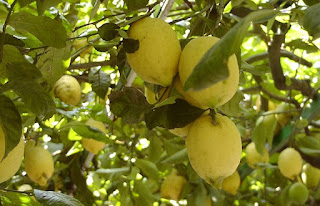 |
| Limoncello |
Getting to Know the Limoncello
Limoncello is an Italian liqueur made from lemons, spirit and syrup, mainly produced in Southern Italy, especially in the region around the Gulf of Naples, the Sorrento Peninsula and the Amalfi coast and the islands of Capri, Ischia and Procida. |
| Gulf of Naples map |
Historically, served as an after-meal liqueur along the Amalfi Coast, its popularity has grown throughout Italy and now has become the second most popular drink after Campari.
Brief History of Limoncello
Distilled grain alcohol has a long history of producing flavored drinks, due to its neutral flavor, which can absorb the flavors of the ingredients such as fruits, spices and herbs infused into it. During the period when the distillation processes were rudimentary and produced a strong, harsh alcoholic drink, some distillers would add different flavors to the alcohol, in an attempt to hide its harsh aftertaste. |
| Limoncello shot glass |
In southern Italy, there are many different stories for the origin of the limoncello, with some attributing its earlier use to fishermen and countrymen who would drink it in the morning to resist the cold, while others say it originated at convents.
The 'Limoncello' trademark was first patented in 1988, by Massimo Canale who opened a small handmade production of limoncello, using an old family recipe. His father, who owned a bar which served the lemon liquor was the nephew of Maria Antonia Farace who is said to have grown lemons and oranges to produce this liquor to serve her guests at her small boarding house in Capri, in the early 1900s.
The Lemons of Sorrento
Though the people from Sorrento, the Amalfi Coast, Capri and the other nearby islands may have their own theories about the origin of the limoncello, there is a common agreement that the lemons from the Sorrento Peninsula make the best limoncello. The peels of these lemons are rich with essential oils, have an intense flavor and provide the characteristic taste of the limoncello.A Brief History
The cultivation of lemons in Sorrento dates back to Roman times. Mosaics and paintings that have survived in ancient Roman towns of Pompeii and Herculaneum show lemons that are shaped remarkably like the lemons grown in Sorrento. The cultivation of lemons during this early period were mainly for ornamental purposes. |
| View of Sorrento in the 19th century by Oswald Achenbach |
Starting from the 11th century the cultivation of lemons along the the Amalfi Coast and Sorrento, started to gradually increase as the awareness of its medicinal use began to spread, particularly for the treatment of scurvy which is caused by a deficiency of vitamin C. Starting from the 18th century, it became an important part of the economy on the Amalfi Coast and Sorrento.
Over the centuries, the farmers of the Sorrento Peninsula, carved out new terraces on the rocky mountain slopes, to grow lemons, where the trees thrived due to the warm climate and volcanic soil conditions.
Different Varieties
There are two main varieties of lemons grown on the Bay of Naples, which are also divided geographically to those grown around Sorrento and those grown on the Amalfi Coast. Both these varieties are known to be fragrant with high levels of vitamin C. The skins are rich in oil and brightly colored, making them ideal for creating the famous limoncello from the Sorrento Peninsula. |
| Sfusato Amalfitano |
The lemons are picked several times each year, although the most important harvest is in the spring-summer period, between March and the end of July.
Both the varieties have an IGP (Protected Geographic Indication) status which applies to agricultural produce of exceptionally high reputation and distinction, relative to its geographical origin.
Production of Limoncello
Limoncello is traditionally made from the Sorrento or Sfusato lemons which are steeped in grain alcohol until the oil is released. The resulting yellow liquid is then mixed with simple syrup and the desired clarity, viscosity, and flavor are achieved through varying the sugar-to-water ratio and the relative temperature of the two liquids.A Basic Limoncello Recipe
The ingredients for preparing limoncello are:8 organic lemons, non-waxed and scrubbed
1 (750 ml.) bottle of grain alcohol (available in Italian supermarkets) or good quality vodka or Everclear
2 cups granulated sugar
4 cups water
- Wash the lemons with hot water to remove any dirt, and then peel them. Remove the white pith which is bitter and unpleasant, and add the peel which has the bright flavor of the lemon, to the jar containing the alcohol.
- Cover the jar and leave in a dark place for a week to a month. The longer the lemon peels are infused, the better the taste will be and more intense the color. Higher proof alcohol, can shorten the flavor extraction period and a good limoncello can be produced with a week of infusion.
- After the flavor of the lemons have been infused into the alcohol, create the syrup, by boiling the water over low heat and dissolving the sugar in it. Let it cool down.
- Remove the lemon peels from the flavored alcohol, using a fine-mesh strainer and then add the syrup to it. If the taste is too harsh, add a little water to mellow the taste. The limoncello will be about 35 percent alcohol (70-proof).
- Cover the jar and store in a dark place for around a month which will help mellow the flavor.
- Filter the alcoholic mixture into clean bottles and store in a cool place or the refrigerator before drinking.
The recipe is simple and with some experimentation you can achieve the desired flavor based on your preference for sweetness or tartness.
 |
| Pastiera and limoncello by Mattia Luigi Nappi |
Article Category: Food History




No comments